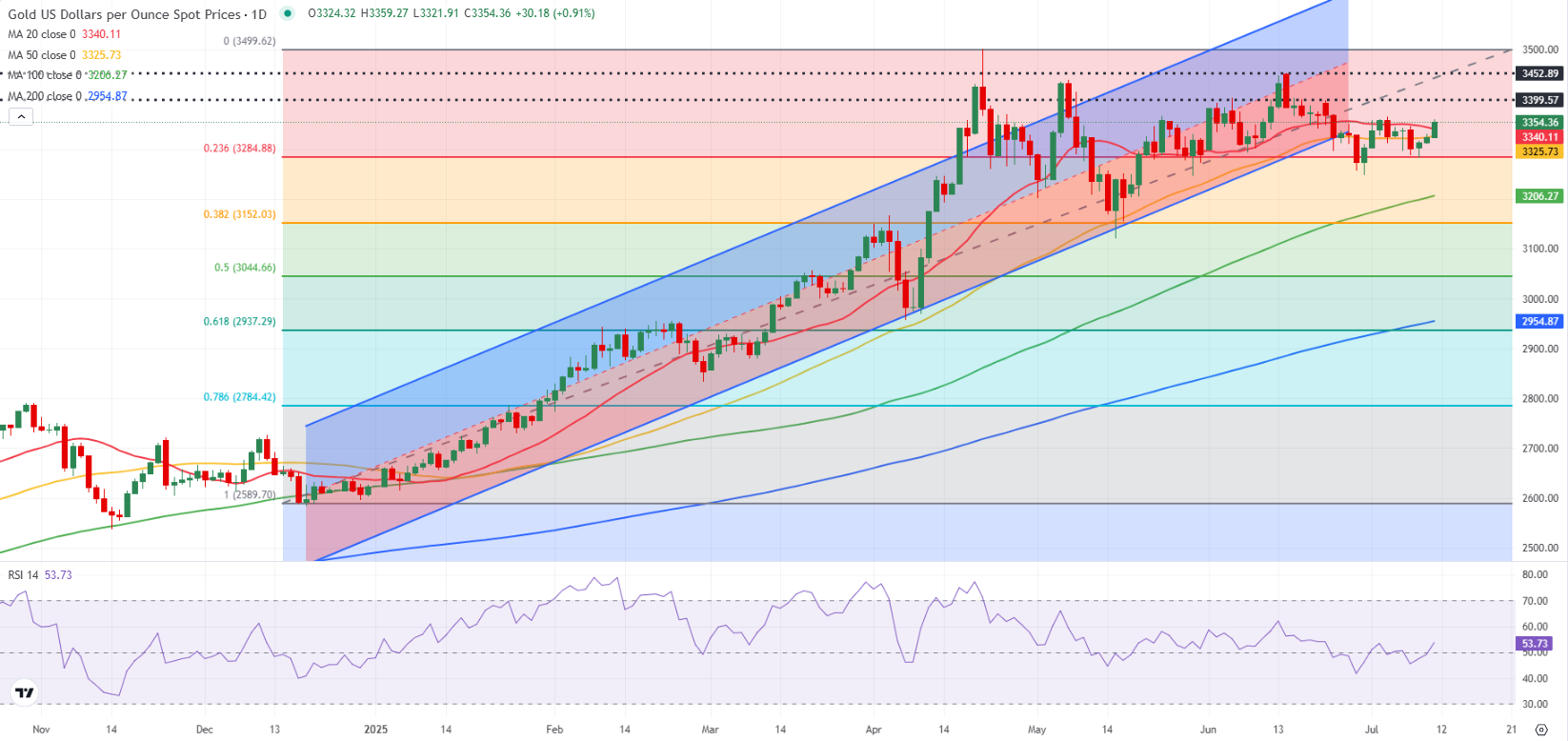XAU/USD Focus: Gold Shines as Risk Premium Builds Ahead of US CPI
The week kicked off with a jolt: President Trump’s administration unleashed a new round of 10% tariffs targeting a swath of BRICS-aligned economies, while also approving a 25% levy on imports from Japan and South Korea. The market’s initial reaction was textbook risk-off—gold prices jumped, only to quickly retrace as traders digested the delayed implementation until August 1. These whipsaws have become a familiar pattern, with institutional players front-running policy surprises and retail investors following suit.
By Tuesday, attention shifted to the industrial metals complex after a surprise 50% copper tariff announcement sent shockwaves through commodities. Gold slipped over 1% in the ensuing volatility, but true to recent form, the dip was bought almost instantly—prices snapping back above $3,300 within hours. The resilience of gold in the face of such swings is a strong tell that market participants are determined to hold strategic positions into the next wave of macro risk events.
The tempo hardly slowed midweek: new guidance from the White House detailed tariffs of 20–30% against emerging markets, while FOMC minutes revealed a split within the Fed. Most policymakers are still anticipating a rate cut by year-end, though many characterize tariff-driven inflation as “transitory” or “modest.” This dichotomy between the short-term inflation spike and the longer-term monetary easing narrative is a key source of gold’s current volatility.
Thursday saw the dollar regain ground on stronger-than-expected US jobless claims (227,000 vs 235,000), putting the brakes on gold’s rally. Yet, by Friday, the market’s risk radar was blaring again: Trump’s talk of 35% tariffs on Canadian goods, along with broad threats of 15–20% duties on other major trading partners, reignited safe-haven flows and propelled gold right back toward the week’s highs above $3,350.
US Inflation and the Fed: The Next Big Catalyst for Gold
As the market pivots into a crucial week for economic data, the US CPI release stands out as the key event risk for gold traders. According to CME FedWatch, the probability of a July rate cut is all but priced out, while a pause in September sits at roughly 30%. If core CPI comes in hot—rising 0.4% or more—expectations for near-term easing will be dialed back, likely driving the dollar higher and putting gold on the defensive. The link between 10-year Treasury yields and gold prices has rarely been this tight; every basis point move in yields is echoed in the gold chart almost in real time.
However, should CPI disappoint or forward-looking inflation expectations soften, the stage is set for another upside surge in XAU/USD as the dollar comes under pressure. The market is hypersensitive to inflation surprises, and even minor deviations from forecast could fuel explosive moves.
This week’s economic docket is dense: Wednesday brings PPI, Thursday delivers retail sales, and Friday wraps with the University of Michigan consumer sentiment survey. Of particular note are inflation expectations one year out—if those indicators ease, it could be the tipping point for another leg up in gold, especially heading into a news-heavy weekend.
Tariff Uncertainty and Market Volatility: The Risk-On/Risk-Off Tug of War
US trade policy remains the single biggest volatility driver for the precious metals complex. With new tariffs hanging in the balance—and plenty of scope for surprise changes before August 1—every headline triggers knee-jerk reactions across FX, commodities, and equities. The dominant theme is a push-and-pull between risk-off panic and fleeting optimism over potential trade breakthroughs. Should tariff fears escalate, gold is primed for breakout moves to fresh all-time highs; conversely, any hints of compromise or de-escalation could see XAU/USD retrace sharply as safe-haven demand ebbs.
Technical Analysis: Gold Bulls Eye $3,400 and $3,450 as Momentum Builds
The technical landscape has become increasingly bullish. The daily RSI is back above 50 and momentum continues to accelerate as gold trades comfortably above its 20- and 50-day moving averages. Immediate resistance stands at $3,400—breaching this level would open the door to $3,450, with the historic $3,500 zone coming into play if bullish sentiment persists. On the downside, first support is at $3,285 (23.6% Fibonacci), with deeper pullbacks targeting the $3,200–$3,205 band (100-day SMA) and then $3,150 (38.2% Fibonacci).
- Break above $3,400: Signals another round of momentum buying, with $3,450–$3,500 as next targets.
- Drop below $3,285: Likely to accelerate selling toward $3,200 and possibly $3,150 if inflation shocks to the upside.
 Gold rallies on inflation, tariff turmoil
Gold rallies on inflation, tariff turmoilKey Takeaways: Strategic Scenarios for Investors
In the near term, gold remains a battleground for macro themes: inflation risk, Fed policy uncertainty, and the ever-changing US trade landscape. Bulls are emboldened by safe-haven flows and aggressive tariff headlines, but the metal’s fate hinges on whether inflation data justifies the Fed’s cautious stance. If CPI overshoots, gold may face a corrective pullback; but any dovish signals from the Fed—or new waves of tariff risk—could swiftly revive upside momentum. For now, the gold market is setting the pace for global risk, and smart money will stay nimble as the week’s events unfold.

